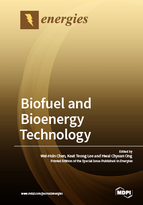Biofuel and Bioenergy Technology
A special issue of Energies (ISSN 1996-1073). This special issue belongs to the section "A: Sustainable Energy".
Deadline for manuscript submissions: closed (20 November 2018) | Viewed by 132121
Special Issue Editors
Interests: bioenergy; hydrogen energy; clean energy; thermoelectric generation; environmental engineering; AI & machine leaning for energy
Special Issues, Collections and Topics in MDPI journals
Interests: energy environment; renewable energy; reaction engineering
Interests: energy and fuel; renewable energy; environmental sustainability; biomass energy; thermal engineering; green technology
Special Issues, Collections and Topics in MDPI journals
Special Issue Information
Dear Colleagues,
Biomass is considered as a renewable resource because of its short life cycle, and biomass-derived biofuels are potential substitutes to fossil fuels. When biomass grows, all carbon in biomass comes from the atmosphere and is liberated into the environment when it is burned. Therefore, biomass is thought of as a carbon-neutral fuel. For these reasons, the development of bioenergy is an effective countermeasure to elongate diminishing fossil fuel reserves, lessen greenhouse gas (GHG) emissions, and mitigate global warming and climate change. Biomass can be converted into biofuels through a variety of routes such as physical, thermochemical, chemical, and biological methods. The common and important biofuels for bioenergy include charcoal, biochar, biodiesel, bioethanol, biobutanol, pyrolysis and liquefaction bio-oils, synthesis gas (syngas), biogas, and biohydrogen. On account of the merit of bioenergy for environmental sustainability, biofuel and bioenergy technology plays a crucial role for renewable energy development. This Special Issue aims to publish high-quality research and review papers addressing recent advances in bioenergy. Studies of advanced techniques and biorefinery for biofuel production are also welcomed. Research involving experimental and numerical studies, recent developments, and novel and emerging technologies in this field are highly encouraged.
Prof. Dr. Wei-Hsin Chen
Prof. Dr. Keat Teong Lee
Prof. Dr. Hwai Chyuan Ong
Guest Editors
Manuscript Submission Information
Manuscripts should be submitted online at www.mdpi.com by registering and logging in to this website. Once you are registered, click here to go to the submission form. Manuscripts can be submitted until the deadline. All submissions that pass pre-check are peer-reviewed. Accepted papers will be published continuously in the journal (as soon as accepted) and will be listed together on the special issue website. Research articles, review articles as well as short communications are invited. For planned papers, a title and short abstract (about 100 words) can be sent to the Editorial Office for announcement on this website.
Submitted manuscripts should not have been published previously, nor be under consideration for publication elsewhere (except conference proceedings papers). All manuscripts are thoroughly refereed through a single-blind peer-review process. A guide for authors and other relevant information for submission of manuscripts is available on the Instructions for Authors page. Energies is an international peer-reviewed open access semimonthly journal published by MDPI.
Please visit the Instructions for Authors page before submitting a manuscript. The Article Processing Charge (APC) for publication in this open access journal is 2600 CHF (Swiss Francs). Submitted papers should be well formatted and use good English. Authors may use MDPI's English editing service prior to publication or during author revisions.
Keywords
- biofuel
- bioenergy
- biorefinery
- physical conversion
- thermochemical conversion
- chemical conversion
- biological conversion
- production optimization
- process design
- thermodynamic analysis








